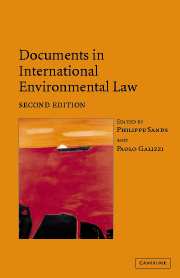Book contents
- Frontmatter
- Contents
- Preface
- PART I General instruments
- PART II Atmosphere
- PART III Oceans: global
- PART IIIB Oceans: regional
- 12 Convention for the Protection of the Marine Environment and the Coastal Region of the Mediterranean, 16 February 1976, as revised in Barcelona, 10 June 1995
- 12A Protocol for the Prevention and Elimination of Pollution of the Mediterranean Sea by Dumping from Ships and Aircraft or Incineration at Sea, 16 February 1976, as revised on 10 June 1995
- 12B Protocol Concerning Co-operation in Preventing Pollution from Ships and, in Cases of Emergency, Combating Pollution of the Mediterranean Sea, 25 January 2002
- 12C Protocol for the Protection of the Mediterranean Sea against Pollution from Land-Based Sources and Activities, 17 May 1980, as amended on 7 March 1996
- 12D Protocol Concerning Specially Protected Areas and Biological Diversity in the Mediterranean, 10 June 1995, and including Annexes adopted on 24 November 1996
- 12E Protocol for the Protection of the Mediterranean Sea against Pollution Resulting from Exploration and Exploitation of the Continental Shelf and the Seabed and its Subsoil, 14 October 1994
- 12F Protocol on the Prevention of Pollution of the Mediterranean Sea by Transboundary Movements of Hazardous Wastes and their Disposal, 1 October 1996
- 13 Convention for the Protection of the Marine Environment of the North-East Atlantic, 22 September 1992
- PART IV Freshwater resources
- PART V Biodiversity
- PART VIA Hazardous substances and activities: nuclear
- PART VIB Hazardous substances and activities: pesticides
- PART VIC Hazardous substances and activities: waste
- PART VII Human rights and the environment
- PART VIII War and the environment
- PART IX Trade and the environment
- PART X Environmental impact assessment and access to information
- PART XI Liability for environmental damage and breaches of environmental obligations
- PART XII The Antarctic
13 - Convention for the Protection of the Marine Environment of the North-East Atlantic, 22 September 1992
Published online by Cambridge University Press: 05 June 2012
- Frontmatter
- Contents
- Preface
- PART I General instruments
- PART II Atmosphere
- PART III Oceans: global
- PART IIIB Oceans: regional
- 12 Convention for the Protection of the Marine Environment and the Coastal Region of the Mediterranean, 16 February 1976, as revised in Barcelona, 10 June 1995
- 12A Protocol for the Prevention and Elimination of Pollution of the Mediterranean Sea by Dumping from Ships and Aircraft or Incineration at Sea, 16 February 1976, as revised on 10 June 1995
- 12B Protocol Concerning Co-operation in Preventing Pollution from Ships and, in Cases of Emergency, Combating Pollution of the Mediterranean Sea, 25 January 2002
- 12C Protocol for the Protection of the Mediterranean Sea against Pollution from Land-Based Sources and Activities, 17 May 1980, as amended on 7 March 1996
- 12D Protocol Concerning Specially Protected Areas and Biological Diversity in the Mediterranean, 10 June 1995, and including Annexes adopted on 24 November 1996
- 12E Protocol for the Protection of the Mediterranean Sea against Pollution Resulting from Exploration and Exploitation of the Continental Shelf and the Seabed and its Subsoil, 14 October 1994
- 12F Protocol on the Prevention of Pollution of the Mediterranean Sea by Transboundary Movements of Hazardous Wastes and their Disposal, 1 October 1996
- 13 Convention for the Protection of the Marine Environment of the North-East Atlantic, 22 September 1992
- PART IV Freshwater resources
- PART V Biodiversity
- PART VIA Hazardous substances and activities: nuclear
- PART VIB Hazardous substances and activities: pesticides
- PART VIC Hazardous substances and activities: waste
- PART VII Human rights and the environment
- PART VIII War and the environment
- PART IX Trade and the environment
- PART X Environmental impact assessment and access to information
- PART XI Liability for environmental damage and breaches of environmental obligations
- PART XII The Antarctic
Summary
Editorial note
The Convention for the Protection of the Marine Environment of the North-East Atlantic, adopted under the auspices of the Paris and Oslo Commissions, has replaced the Oslo Convention for the Prevention of Marine Pollution by Dumping from Ships and Aircraft, 1972 and the Paris Convention for the Prevention of Marine Pollution by Land-Based Sources, 1974. Its central obligation requires Parties to adopt programmes and measures to ‘prevent and eliminate pollution’ of the maritime area (Article 2(1)). To that end, the Convention requires the Parties to apply: (a) the precautionary principle, whereby preventive measures to forestall risks to human health, the environment or legitimate uses of the sea are taken ‘even where there is no conclusive evidence of a causal relationship between the inputs and the effects’ (Article 2(2)(a)); and (b) the polluter pays principle, whereby the polluter bears the costs of pollution prevention, control and reduction (Article 2(2)(b)). In implementing the Convention, Parties are required to take into account the criteria in Appendix I to apply ‘best available techniques’ and ‘best environmental practice’, including, where appropriate, ‘clean technology’. The Convention does not prevent the Parties from taking more stringent provisions than those set out in the Convention (Article 2(5)).
The Annexes to the Convention provide specific regulation on the prevention and elimination of pollution from: land-based sources (Article 3, Annex I); dumping or incineration (Article 4, Annex II); and offshore sources (Article 5, Annex III).
- Type
- Chapter
- Information
- Documents in International Environmental Law , pp. 505 - 536Publisher: Cambridge University PressPrint publication year: 2004
- 1
- Cited by



